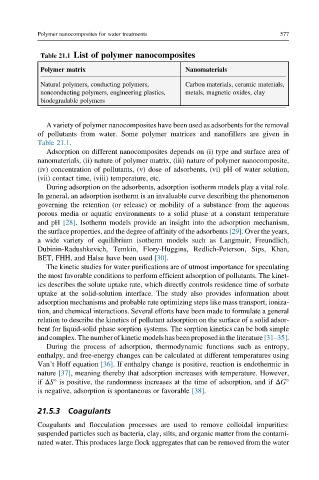Page 625 - Polymer-based Nanocomposites for Energy and Environmental Applications
P. 625
Polymer nanocomposites for water treatments 577
Table 21.1 List of polymer nanocomposites
Polymer matrix Nanomaterials
Natural polymers, conducting polymers, Carbon materials, ceramic materials,
nonconducting polymers, engineering plastics, metals, magnetic oxides, clay
biodegradable polymers
A variety of polymer nanocomposites have been used as adsorbents for the removal
of pollutants from water. Some polymer matrices and nanofillers are given in
Table 21.1.
Adsorption on different nanocomposites depends on (i) type and surface area of
nanomaterials, (ii) nature of polymer matrix, (iii) nature of polymer nanocomposite,
(iv) concentration of pollutants, (v) dose of adsorbents, (vi) pH of water solution,
(vii) contact time, (viii) temperature, etc.
During adsorption on the adsorbents, adsorption isotherm models play a vital role.
In general, an adsorption isotherm is an invaluable curve describing the phenomenon
governing the retention (or release) or mobility of a substance from the aqueous
porous media or aquatic environments to a solid phase at a constant temperature
and pH [28]. Isotherm models provide an insight into the adsorption mechanism,
the surface properties, and the degree of affinity of the adsorbents [29]. Over the years,
a wide variety of equilibrium isotherm models such as Langmuir, Freundlich,
Dubinin-Radushkevich, Temkin, Flory-Huggins, Redlich-Peterson, Sips, Khan,
BET, FHH, and Halse have been used [30].
The kinetic studies for water purifications are of utmost importance for speculating
the most favorable conditions to perform efficient adsorption of pollutants. The kinet-
ics describes the solute uptake rate, which directly controls residence time of sorbate
uptake at the solid-solution interface. The study also provides information about
adsorption mechanisms and probable rate optimizing steps like mass transport, ioniza-
tion, and chemical interactions. Several efforts have been made to formulate a general
relation to describe the kinetics of pollutant adsorption on the surface of a solid adsor-
bent for liquid-solid phase sorption systems. The sorption kinetics can be both simple
and complex. The number of kinetic models has been proposed in the literature [31–35].
During the process of adsorption, thermodynamic functions such as entropy,
enthalpy, and free-energy changes can be calculated at different temperatures using
Van’t Hoff equation [36]. If enthalpy change is positive, reaction is endothermic in
nature [37], meaning thereby that adsorption increases with temperature. However,
if ΔS° is positive, the randomness increases at the time of adsorption, and if ΔG°
is negative, adsorption is spontaneous or favorable [38].
21.5.3 Coagulants
Coagulants and flocculation processes are used to remove colloidal impurities:
suspended particles such as bacteria, clay, silts, and organic matter from the contami-
nated water. This produces large flock aggregates that can be removed from the water

